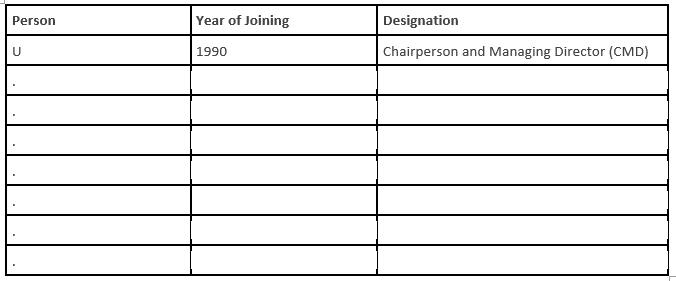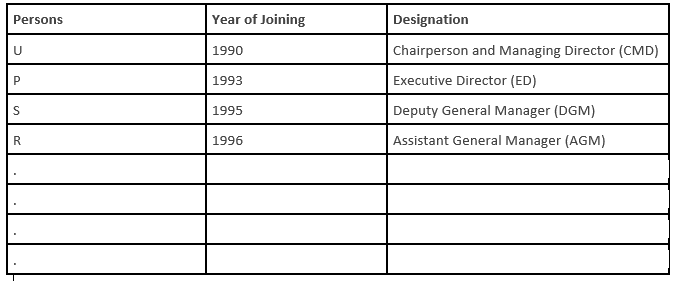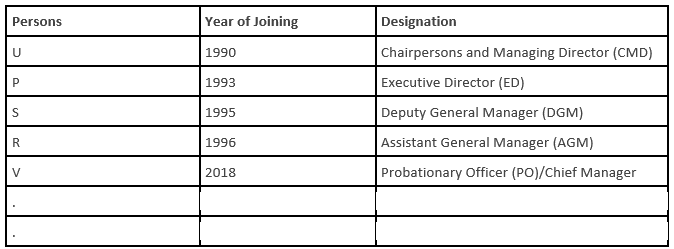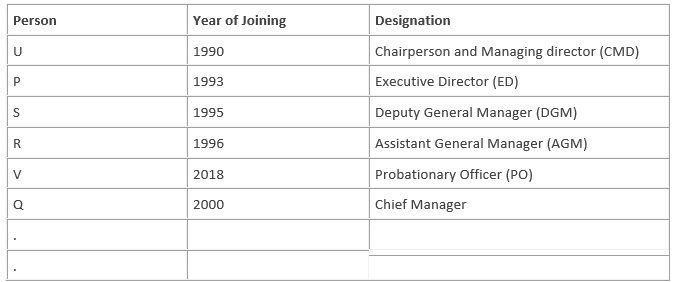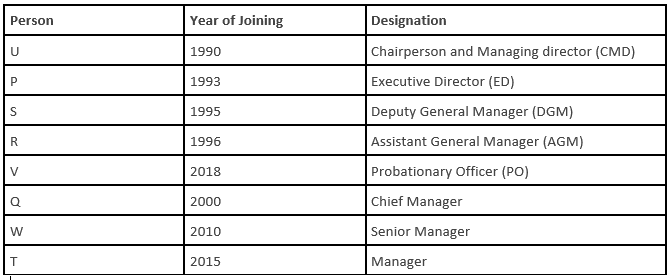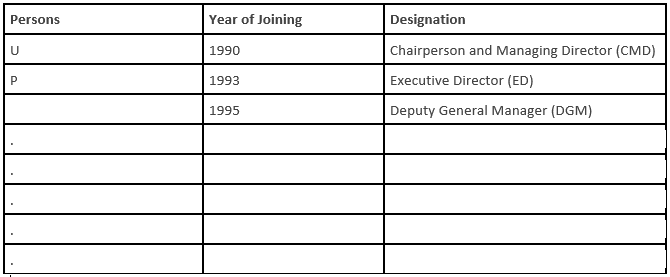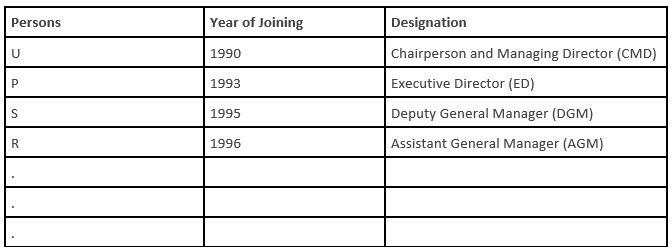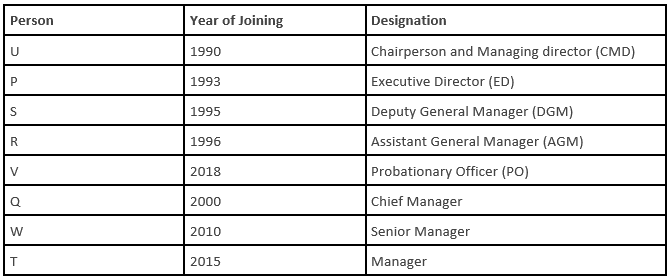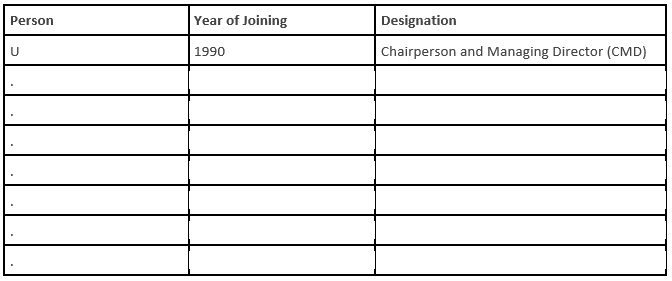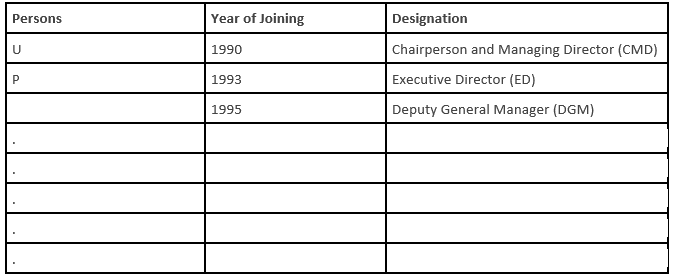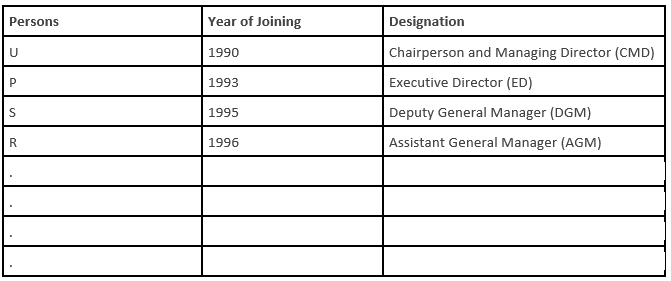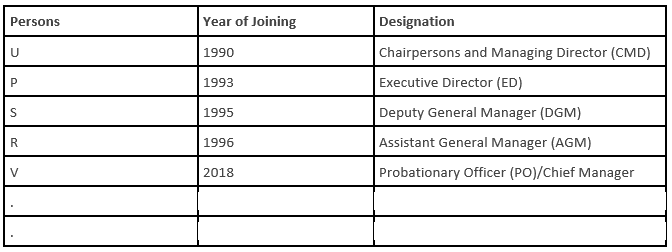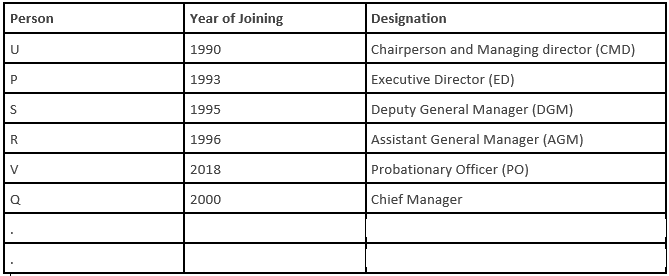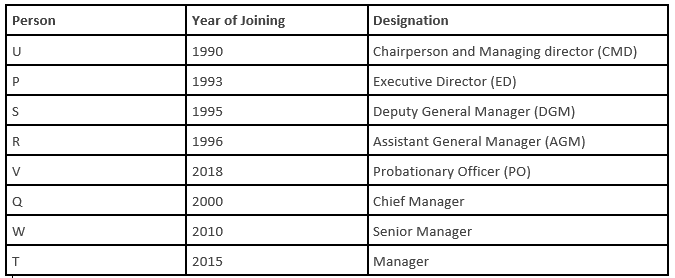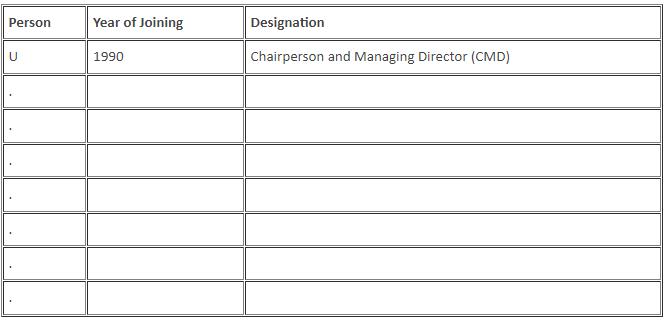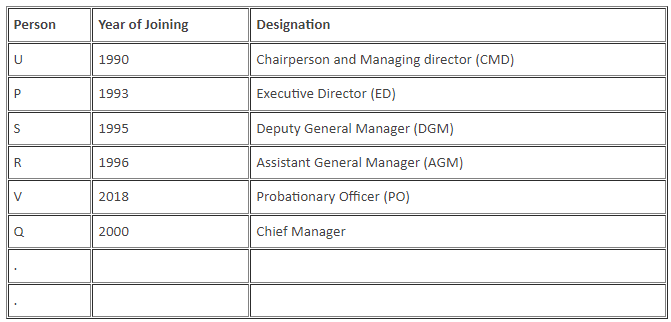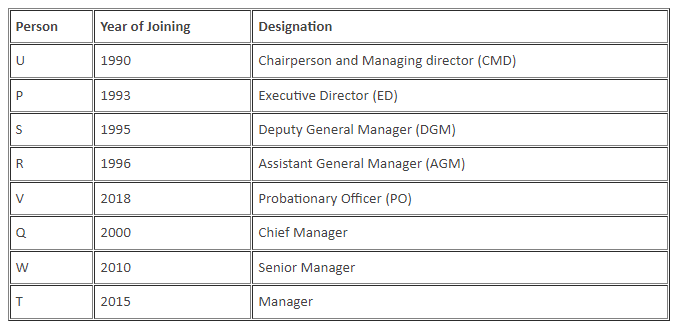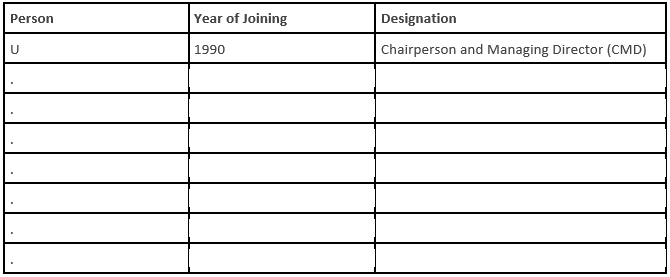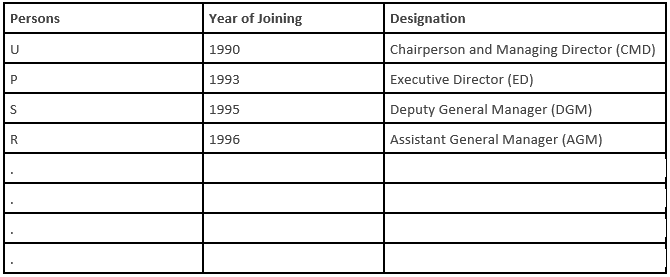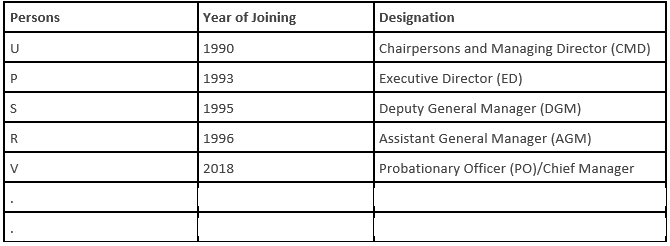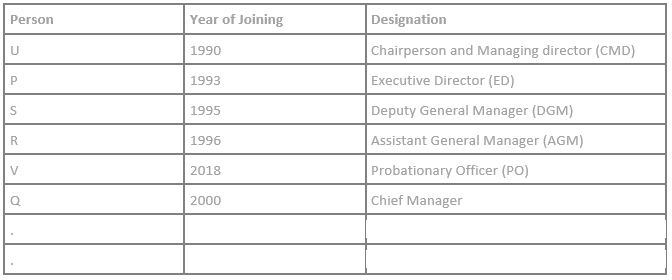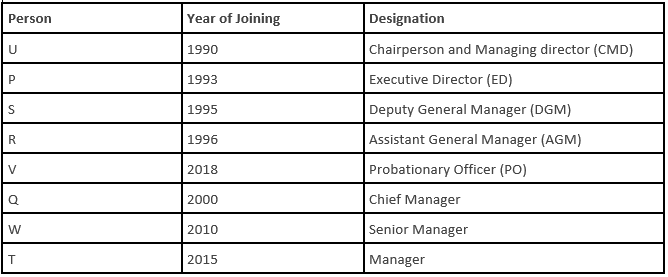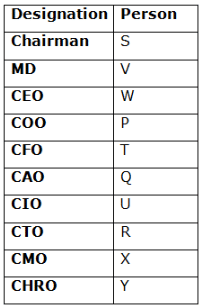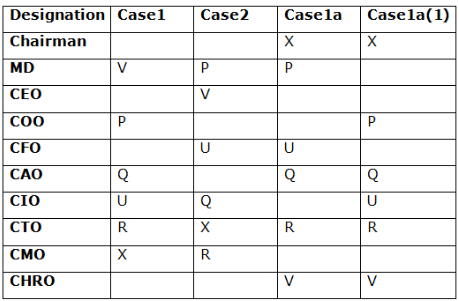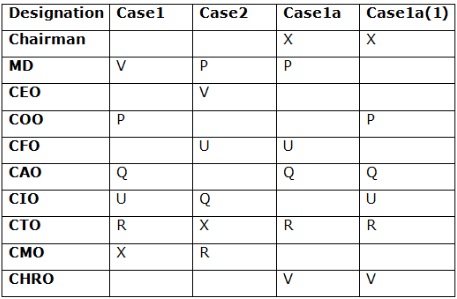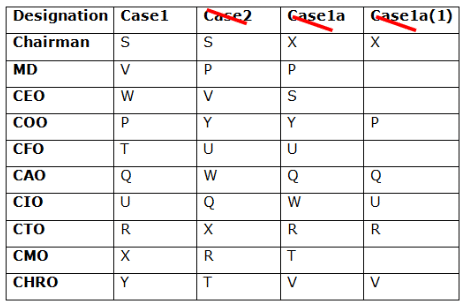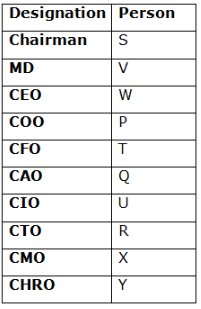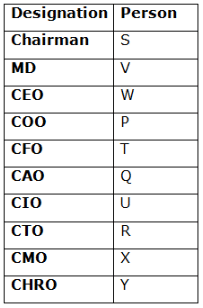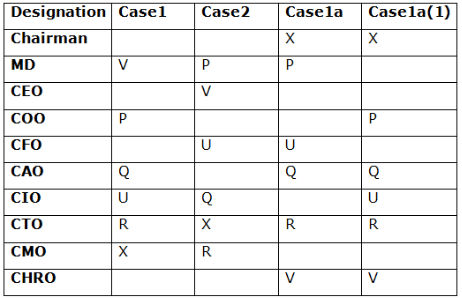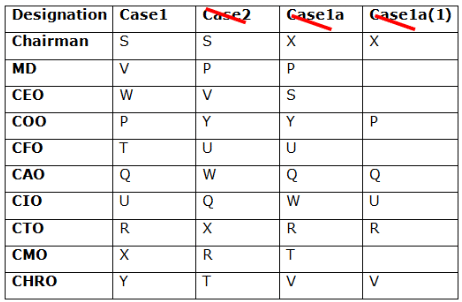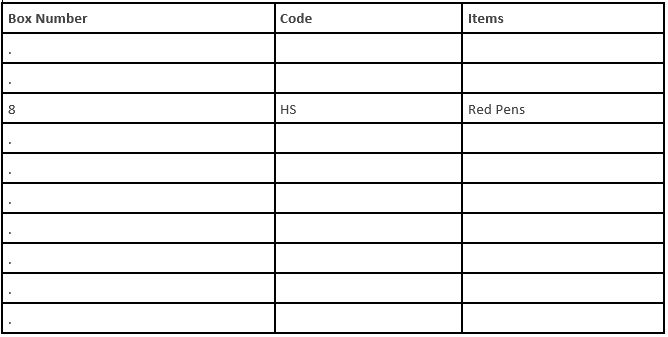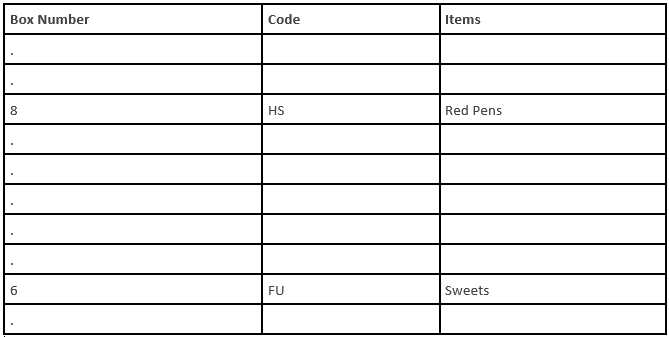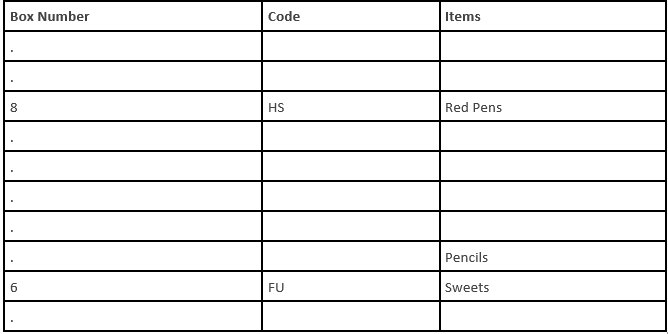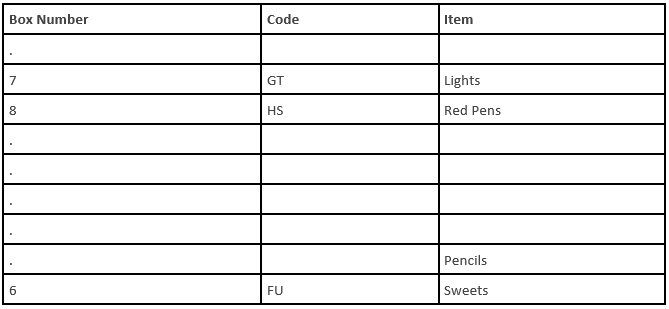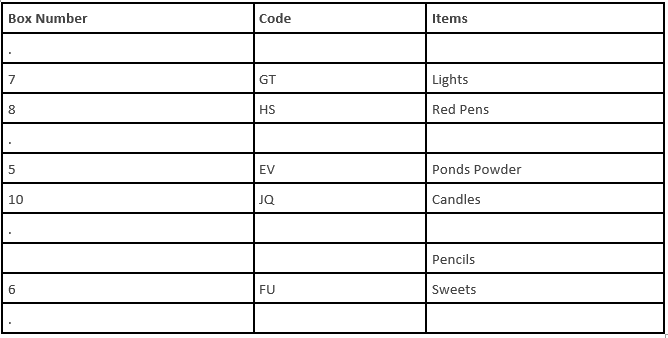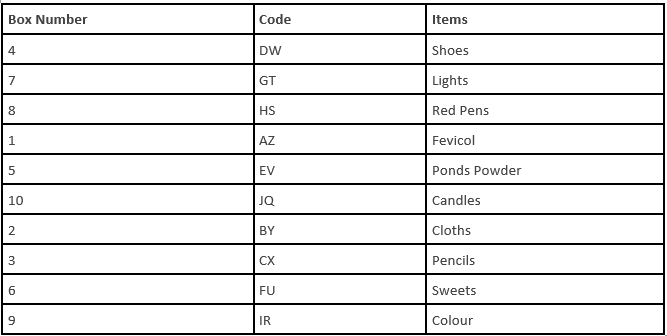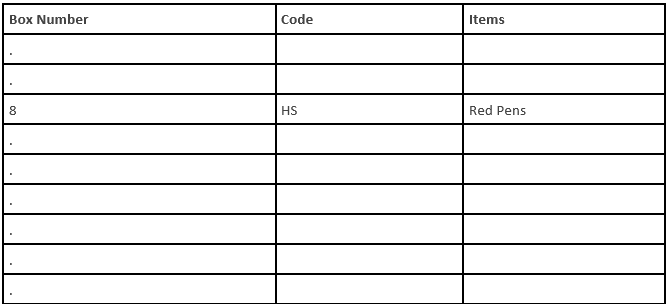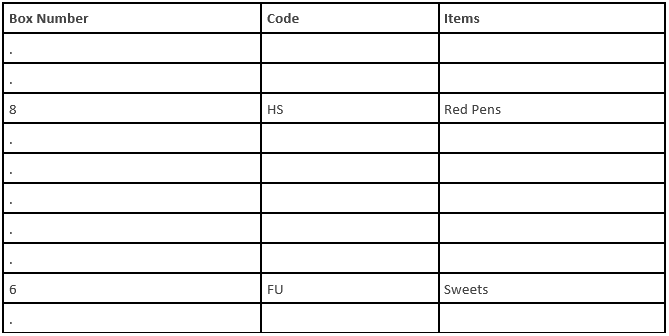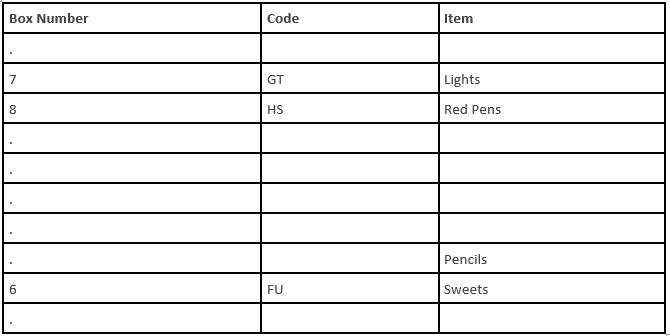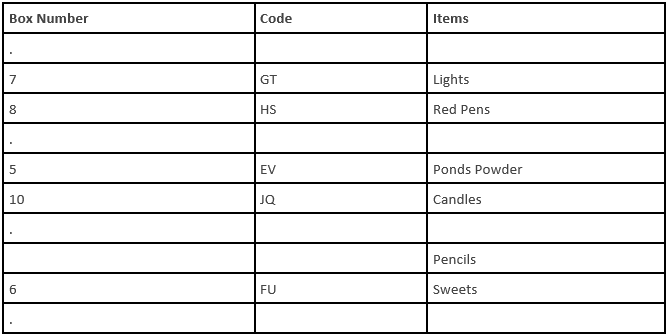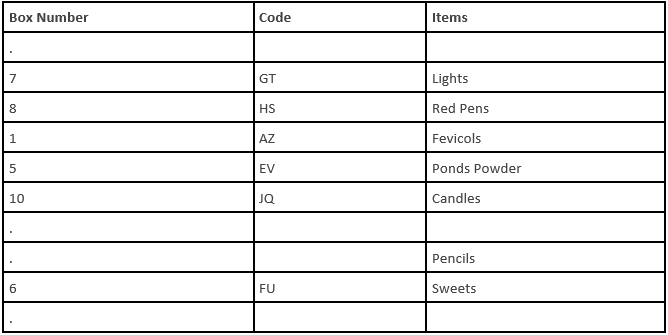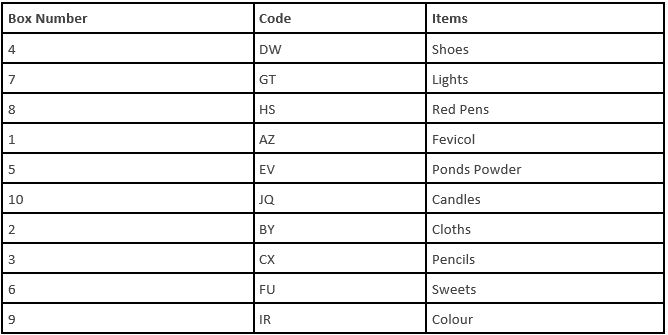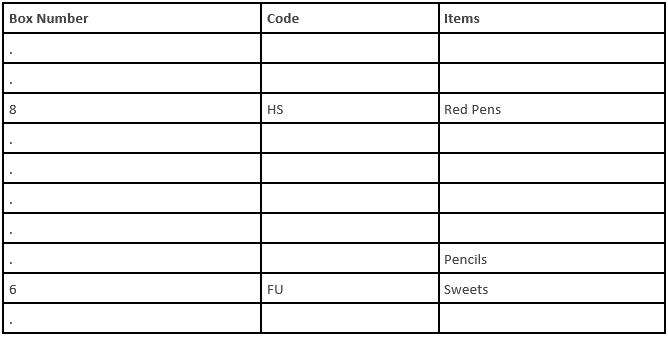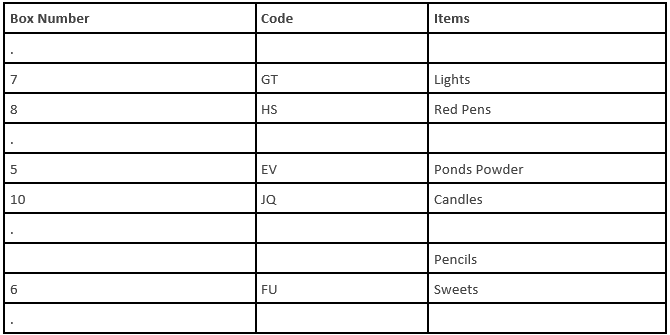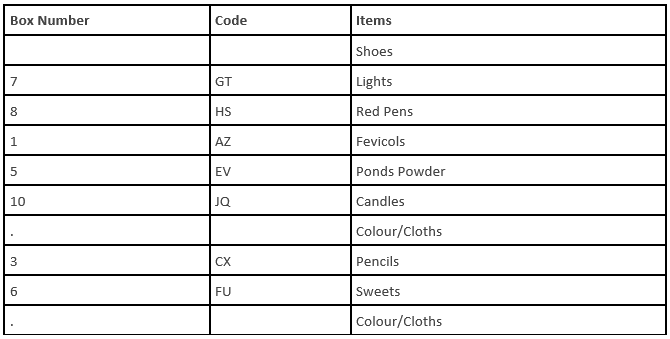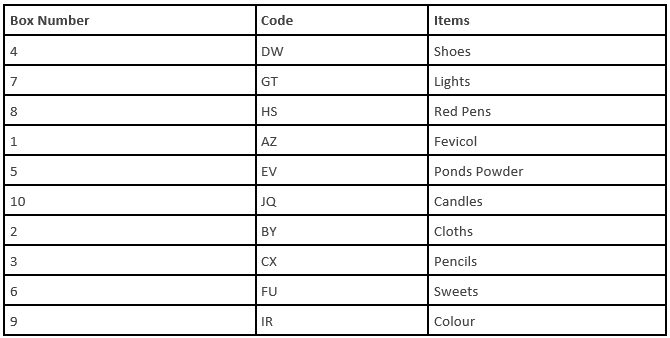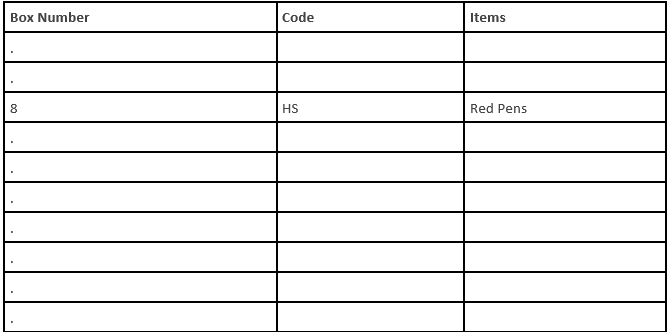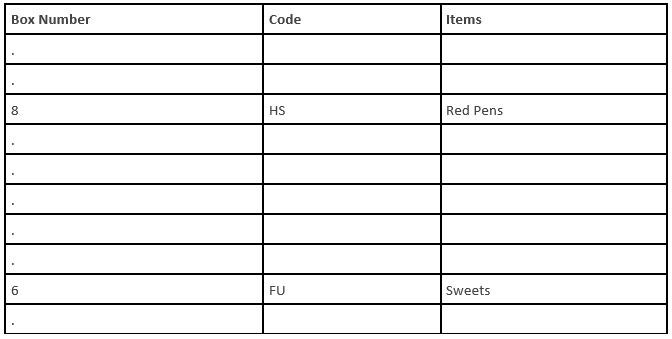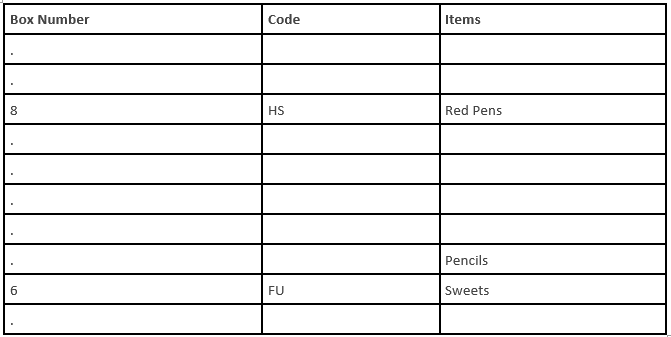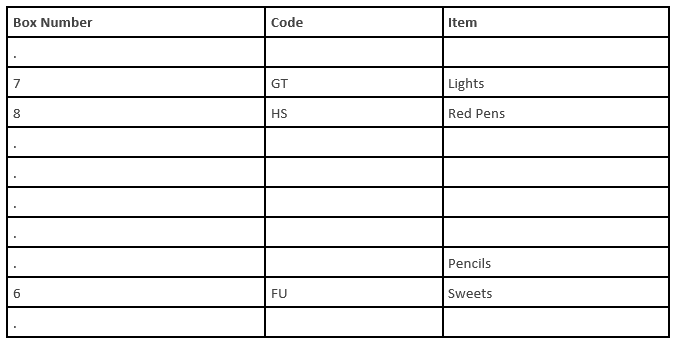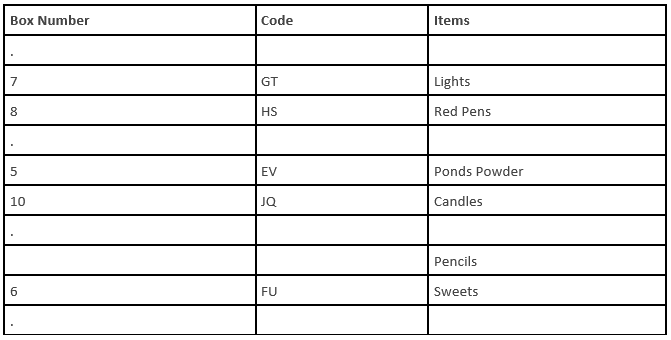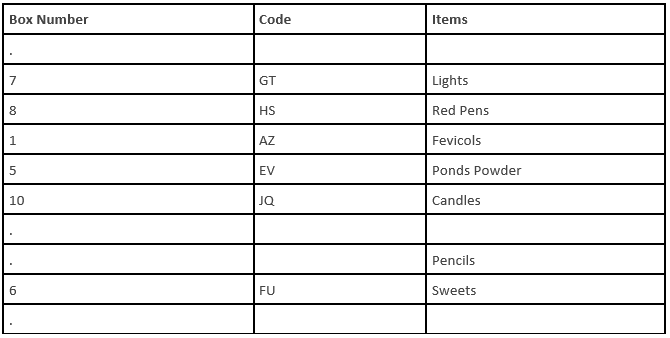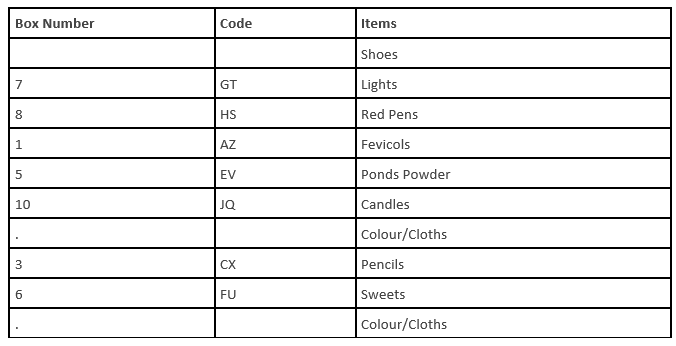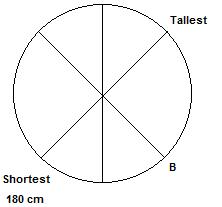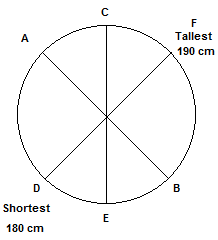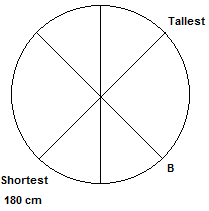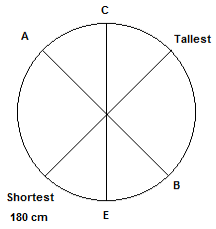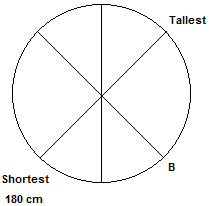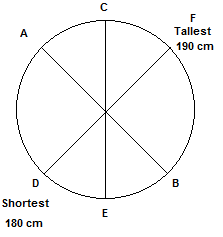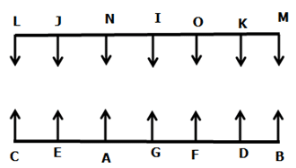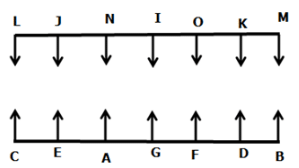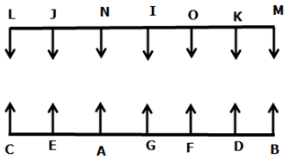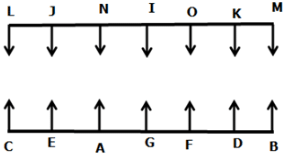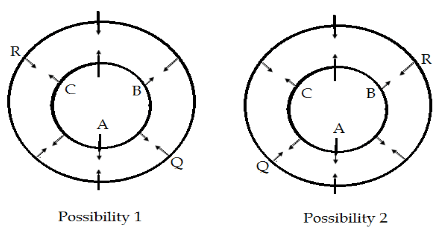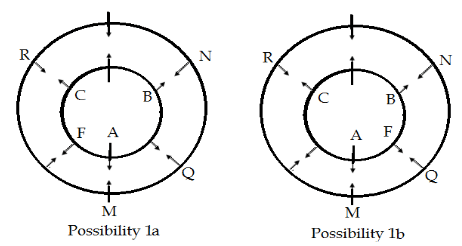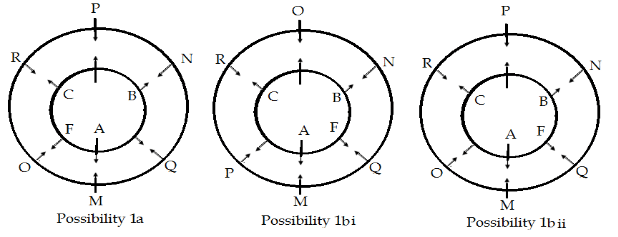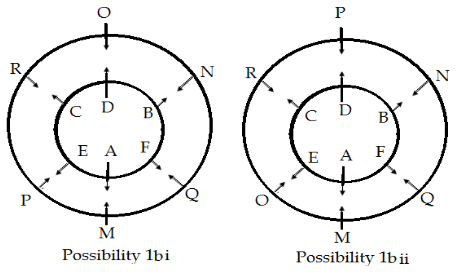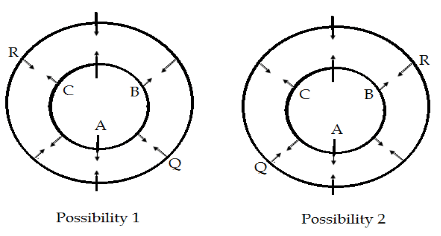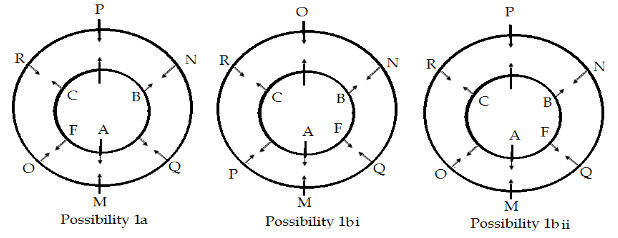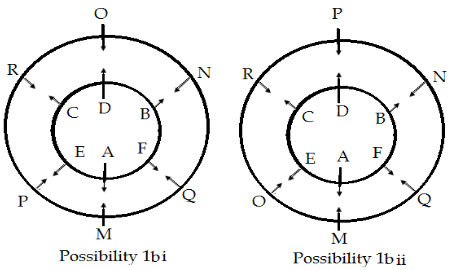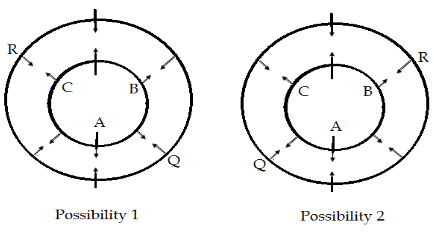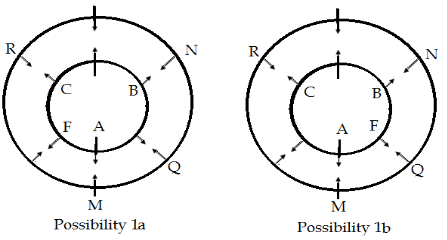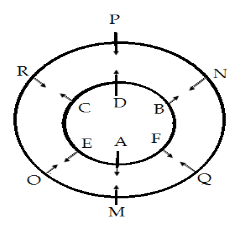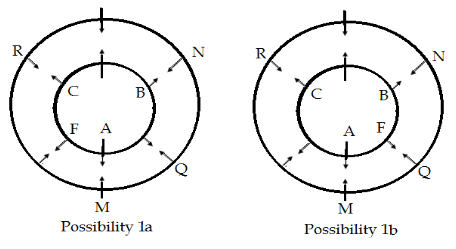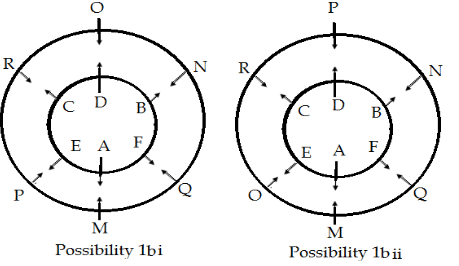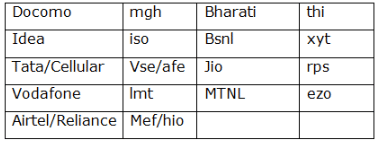RBI Assistant Mains Mock Test - 2 - Bank Exams MCQ
30 Questions MCQ Test RBI Assistant Mock Test Series & Past Year Papers 2025 - RBI Assistant Mains Mock Test - 2
Directions: Study the following information carefully and answer the question given below:
P, Q, R, S, T, U, V and W are eight persons working in a 30 years old bank with different years of joining: 1990, 1993, 1995, 1996, 2000, 2010, 2015 and 2018. They are not necessarily in the same order. All of them have different designations in the bank namely Probationary Officer (PO), Manager, Senior Manager, Chief Manager, Assistant General Manager (AGM), Deputy General Manager (DGM), Executive Director (ED) and Chairperson and Managing Director (CMD), but not necessarily in the same order.
U is the oldest serving person in the bank. The Executive Director and Deputy General Manager joined at a gap of two years where Executive Director (ED) joined the bank first.
The oldest serving employee is the Chairperson and Managing Director (CMD) and P is the Executive Director (ED). R is Assistant General Manager (AGM) and joined one year after S and S joined in 1995. V is the last one to join the bank and he is neither Manager nor Senior Manager. Q is the first person to join in the twentieth century and is Chief Manager. W joined the bank in 2010 and is the Senior Manager. T did not join in 2018 and isn't the Probationary Officer.
Which of the following combinations is/are true?
(i) Q – 1995 – Deputy General Manager
(ii) T – 2015 – Manager
(iii) V – 2018 – Probationary Officer
(iv) R – 1996 – Assistant General Manager
Directions: Study the following information carefully and answer the question given below:
P, Q, R, S, T, U, V and W are eight persons working in a 30 years old bank with different years of joining: 1990, 1993, 1995, 1996, 2000, 2010, 2015 and 2018. They are not necessarily in the same order. All of them have different designations in the bank namely Probationary Officer (PO), Manager, Senior Manager, Chief Manager, Assistant General Manager (AGM), Deputy General Manager (DGM), Executive Director (ED) and Chairperson and Managing Director (CMD), but not necessarily in the same order.
U is the oldest serving person in the bank. The Executive Director and Deputy General Manager joined at a gap of two years where Executive Director (ED) joined the bank first.
The oldest serving employee is the Chairperson and Managing Director (CMD) and P is the Executive Director (ED). R is Assistant General Manager (AGM) and joined one year after S and S joined in 1995. V is the last one to join the bank and he is neither Manager nor Senior Manager. Q is the first person to join in the twentieth century and is Chief Manager. W joined the bank in 2010 and is the Senior Manager. T did not join in 2018 and isn't the Probationary Officer.
Which year did person P join the bank and what is his designation?
Directions: Study the following information carefully and answer the question given below:
P, Q, R, S, T, U, V and W are eight persons working in a 30 years old bank with different years of joining: 1990, 1993, 1995, 1996, 2000, 2010, 2015 and 2018. They are not necessarily in the same order. All of them have different designations in the bank namely Probationary Officer (PO), Manager, Senior Manager, Chief Manager, Assistant General Manager (AGM), Deputy General Manager (DGM), Executive Director (ED) and Chairperson and Managing Director (CMD), but not necessarily in the same order.
U is the oldest serving person in the bank. The Executive Director and Deputy General Manager joined at a gap of two years where Executive Director (ED) joined the bank first.
The oldest serving employee is the Chairperson and Managing Director (CMD) and P is the Executive Director (ED). R is Assistant General Manager (AGM) and joined one year after S and S joined in 1995. V is the last one to join the bank and he is neither Manager nor Senior Manager. Q is the first person to join in the twentieth century and is Chief Manager. W joined the bank in 2010 and is the Senior Manager. T did not join in 2018 and isn't the Probationary Officer.
Who is likely to become the next Chairperson and Managing Director (CMD) if bank considers the persons with the most number of years spent in the bank?
Directions: Study the following information carefully and answer the question given below:
P, Q, R, S, T, U, V and W are eight persons working in a 30 years old bank with different years of joining: 1990, 1993, 1995, 1996, 2000, 2010, 2015 and 2018. They are not necessarily in the same order. All of them have different designations in the bank namely Probationary Officer (PO), Manager, Senior Manager, Chief Manager, Assistant General Manager (AGM), Deputy General Manager (DGM), Executive Director (ED) and Chairperson and Managing Director (CMD), but not necessarily in the same order.
U is the oldest serving person in the bank. The Executive Director and Deputy General Manager joined at a gap of two years where Executive Director (ED) joined the bank first.
The oldest serving employee is the Chairperson and Managing Director (CMD) and P is the Executive Director (ED). R is Assistant General Manager (AGM) and joined one year after S and S joined in 1995. V is the last one to join the bank and he is neither Manager nor Senior Manager. Q is the first person to join in the twentieth century and is Chief Manager. W joined the bank in 2010 and is the Senior Manager. T did not join in 2018 and isn't the Probationary Officer.
Who is the Manager?
Directions: Study the following information carefully and answer the question given below:
P, Q, R, S, T, U, V and W are eight persons working in a 30 years old bank with different years of joining: 1990, 1993, 1995, 1996, 2000, 2010, 2015 and 2018. They are not necessarily in the same order. All of them have different designations in the bank namely Probationary Officer (PO), Manager, Senior Manager, Chief Manager, Assistant General Manager (AGM), Deputy General Manager (DGM), Executive Director (ED) and Chairperson and Managing Director (CMD), but not necessarily in the same order.
U is the oldest serving person in the bank. The Executive Director and Deputy General Manager joined at a gap of two years where Executive Director (ED) joined the bank first.
The oldest serving employee is the Chairperson and Managing Director (CMD) and P is the Executive Director (ED). R is Assistant General Manager (AGM) and joined one year after S and S joined in 1995. V is the last one to join the bank and he is neither Manager nor Senior Manager. Q is the first person to join in the twentieth century and is Chief Manager. W joined the bank in 2010 and is the Senior Manager. T did not join in 2018 and isn't the Probationary Officer.
What is the difference in the years of joining of the Assistant General Manager and Probationary Officer?
(e)20
Study the following information carefully and answer the below questions
Ten persons- P, Q, R, S, T, U, V, W, X and Y are working in the company on different designations. The designations of the people in decreasing order are as follows Chairman, MD, CEO, COO, CFO, CAO, CIO, CTO, CMO, and CHRO. All the information is not necessarily in the same order.
Q works three positions senior to the one who works immediately junior to R. More than four persons are senior to Q. Only three persons are holding the positions between Q and V. The number of persons senior to V is the same as the number of persons junior to X. P works immediately junior to the one who works four positions senior to U. P neither works as CHRO nor CIO. The number of persons holds the position between P and Q is the same as the number of persons hold the position between R and Y. W is senior to T but not senior to S. T is neither CMO nor CHRO.
On which of the following designation does R work?
Study the following information carefully and answer the below questions
Ten persons- P, Q, R, S, T, U, V, W, X and Y are working in the company on different designations. The designations of the people in decreasing order are as follows Chairman, MD, CEO, COO, CFO, CAO, CIO, CTO, CMO, and CHRO. All the information is not necessarily in the same order.
Q works three positions senior to the one who works immediately junior to R. More than four persons are senior to Q. Only three persons are holding the positions between Q and V. The number of persons senior to V is the same as the number of persons junior to X. P works immediately junior to the one who works four positions senior to U. P neither works as CHRO nor CIO. The number of persons holds the position between P and Q is the same as the number of persons hold the position between R and Y. W is senior to T but not senior to S. T is neither CMO nor CHRO.
Four of the following five are alike in a certain way. Who among the following one does not belong to the group?
Study the following information carefully and answer the below questions
Ten persons- P, Q, R, S, T, U, V, W, X and Y are working in the company on different designations. The designations of the people in decreasing order are as follows Chairman, MD, CEO, COO, CFO, CAO, CIO, CTO, CMO, and CHRO. All the information is not necessarily in the same order.
Q works three positions senior to the one who works immediately junior to R. More than four persons are senior to Q. Only three persons are holding the positions between Q and V. The number of persons senior to V is the same as the number of persons junior to X. P works immediately junior to the one who works four positions senior to U. P neither works as CHRO nor CIO. The number of persons holds the position between P and Q is the same as the number of persons hold the position between R and Y. W is senior to T but not senior to S. T is neither CMO nor CHRO.
Who among the following person works as COO?
Study the following information carefully and answer the below questions
Ten persons- P, Q, R, S, T, U, V, W, X and Y are working in the company on different designations. The designations of the people in decreasing order are as follows Chairman, MD, CEO, COO, CFO, CAO, CIO, CTO, CMO, and CHRO. All the information is not necessarily in the same order.
Q works three positions senior to the one who works immediately junior to R. More than four persons are senior to Q. Only three persons are holding the positions between Q and V. The number of persons senior to V is the same as the number of persons junior to X. P works immediately junior to the one who works four positions senior to U. P neither works as CHRO nor CIO. The number of persons holds the position between P and Q is the same as the number of persons hold the position between R and Y. W is senior to T but not senior to S. T is neither CMO nor CHRO.
How many persons are senior to T?
Directions: Study the following information and answer the question given below:
There are ten boxes numbered from 1 to 10 which are stacked one above another, but not necessarily in the same order. The box numbered 1 is coded as AZ, the box numbered 2 is coded as BY, the box numbered 3 is coded as CX…………..the box numbered 10 is coded as JQ. These boxes contain different items- Red Pens, Pencils, Colours, Fevicols, Ponds Powder, Candles, Cloths, Lights, Sweets and Shoes, but not necessarily in the same order.
Note: The box which contains Red Pens is numbered with a number which is coded as HS and it is placed third from the top of the stack. The box which is second from the bottom of stack is numbered 6 and contains Sweets. The box which contains Pencils is just above the box which is coded as FU. The box which is placed second from the top of the stack contains Lights and is number which is coded as GT. The half of the number marked on the box of Candles is equal to the number marked on the box which is kept at sixth from the bottom of the stack which contains Ponds Powder. The box which contains Ponds Powder is just above the box which contains Candles. Candles are kept in the box numbered with a number which is coded as JQ. The box which contains Fevicols is numbered with a number which is coded as AZ and is placed just below the box which contain Red Pens. The box which contains Pencils is numbered as 3.
The top most box does not contain Colours or Cloths. The bottom most box does not contain Clothes or Shoes. The top most box is not coded as BY or IR while the bottom most box is not coded as BY or DW.
Which of the following is/are the correct combination?
(i) Box Number 4 – DW – Shoes
(ii) Box Number 5 – EV – Ponds Powder
(iii) Box Number 10 – BY – Cloths
(iv) Box Number 9 – IR – Colours
Directions: Study the following information and answer the question given below:
There are ten boxes numbered from 1 to 10 which are stacked one above another, but not necessarily in the same order. The box numbered 1 is coded as AZ, the box numbered 2 is coded as BY, the box numbered 3 is coded as CX…………..the box numbered 10 is coded as JQ. These boxes contain different items- Red Pens, Pencils, Colours, Fevicols, Ponds Powder, Candles, Cloths, Lights, Sweets and Shoes, but not necessarily in the same order.
Note: The box which contains Red Pens is numbered with a number which is coded as HS and it is placed third from the top of the stack. The box which is second from the bottom of stack is numbered 6 and contains Sweets. The box which contains Pencils is just above the box which is coded as FU. The box which is placed second from the top of the stack contains Lights and is number which is coded as GT. The half of the number marked on the box of Candles is equal to the number marked on the box which is kept at sixth from the bottom of the stack which contains Ponds Powder. The box which contains Ponds Powder is just above the box which contains Candles. Candles are kept in the box numbered with a number which is coded as JQ. The box which contains Fevicols is numbered with a number which is coded as AZ and is placed just below the box which contain Red Pens. The box which contains Pencils is numbered as 3.
The top most box does not contain Colours or Cloths. The bottom most box does not contain Cloths or Shoes. The top most box is not coded as BY or IR while the bottom most box is not coded as BY or DW.
Which of the following combinations is incorrect?
Directions: Study the following information and answer the question given below:
There are ten boxes numbered from 1 to 10 which are stacked one above another, but not necessarily in the same order. The box numbered 1 is coded as AZ, the box numbered 2 is coded as BY, the box numbered 3 is coded as CX…………..the box numbered 10 is coded as JQ. These boxes contain different items- Red Pens, Pencils, Colours, Fevicols, Ponds Powder, Candles, Cloths, Lights, Sweets and Shoes, but not necessarily in the same order.
Note: The box which contains Red Pens is numbered with a number which is coded as HS and it is placed third from the top of the stack. The box which is second from the bottom of stack is numbered 6 and contains Sweets. The box which contains Pencils is just above the box which is coded as FU. The box which is placed second from the top of the stack contains Lights and is number which is coded as GT. The half of the number marked on the box of Candles is equal to the number marked on the box which is kept at sixth from the bottom of the stack which contains Ponds Powder. The box which contains Ponds Powder is just above the box which contains Candles. Candles are kept in the box numbered with a number which is coded as JQ. The box which contains Fevicols is numbered with a number which is coded as AZ and is placed just below the box which contain Red Pens. The box which contains Pencils is numbered as 3.
The top most box does not contain Colours or Cloths. The bottom most box does not contain Cloths or Shoes. The top most box is not coded as BY or IR while the bottom most box is not coded as BY or DW.
Which of the following does not belong to the group?
Directions: Study the following information and answer the question given below:
There are ten boxes numbered from 1 to 10 which are stacked one above another, but not necessarily in the same order. The box numbered 1 is coded as AZ, the box numbered 2 is coded as BY, the box numbered 3 is coded as CX…………..the box numbered 10 is coded as JQ. These boxes contain different items- Red Pens, Pencils, Colours, Fevicols, Ponds Powder, Candles, Cloths, Lights, Sweets and Shoes, but not necessarily in the same order.
Note: The box which contains Red Pens is numbered with a number which is coded as HS and it is placed third from the top of the stack. The box which is second from the bottom of stack is numbered 6 and contains Sweets. The box which contains Pencils is just above the box which is coded as FU. The box which is placed second from the top of the stack contains Lights and is number which is coded as GT. The half of the number marked on the box of Candles is equal to the number marked on the box which is kept at sixth from the bottom of the stack which contains Ponds Powder. The box which contains Ponds Powder is just above the box which contains Candles. Candles are kept in the box numbered with a number which is coded as JQ. The box which contains Fevicols is numbered with a number which is coded as AZ and is placed just below the box which contain Red Pens. The box which contains Pencils is numbered as 3.
The top most box does not contain Colours or Cloths. The bottom most box does not contain Cloths or Shoes. The top most box is not coded as BY or IR while the bottom most box is not coded as BY or DW.
What are the codes of the boxes which contain Ponds Powder and Cloths, respectively?
Directions: Study the following information and answer the question given below:
There are ten boxes numbered from 1 to 10 which are stacked one above another, but not necessarily in the same order. The box numbered 1 is coded as AZ, the box numbered 2 is coded as BY, the box numbered 3 is coded as CX…………..the box numbered 10 is coded as JQ. These boxes contain different items- Red Pens, Pencils, Colours, Fevicols, Ponds Powder, Candles, Cloths, Lights, Sweets and Shoes, but not necessarily in the same order.
Note: The box which contains Red Pens is numbered with a number which is coded as HS and it is placed third from the top of the stack. The box which is second from the bottom of stack is numbered 6 and contains Sweets. The box which contains Pencils is just above the box which is coded as FU. The box which is placed second from the top of the stack contains Lights and is number which is coded as GT. The half of the number marked on the box of Candles is equal to the number marked on the box which is kept at sixth from the bottom of the stack which contains Ponds Powder. The box which contains Ponds Powder is just above the box which contains Candles. Candles are kept in the box numbered with a number which is coded as JQ. The box which contains Fevicols is numbered with a number which is coded as AZ and is placed just below the box which contain Red Pens. The box which contains Pencils is numbered as 3.
The top most box does not contain Colours or Cloths. The bottom most box does not contain Cloths or Shoes. The top most box is not coded as BY or IR while the bottom most box is not coded as BY or DW.
Which of the following items are contained in Box Number 8 and Box Number 10, respectively?
Study the following information carefully and answer the below questions.
A machine rearrange given input line having words in a particular set of rules in step by step. The following is an illustration of input and its rearrangement.
Input: 2 ! # 5 B N % E 9 S 6 @ L P 4 & A 8 Q Z ^ * U 7
Step I: 2 ! # 5 B N E 9 S 6 @ L P 4 A 8 Q Z ^ U 7 % & *
Step II: 2 4 6 8 ! # 5 B N E 9 S @ L P A Q Z ^ U 7 % & *
Step III: 2 4 6 8 ! # 5 B N E 9 S @ L P Q A Z ^ U 7 % & *
Step IV: 2 4 6 8 ! # B N E S @ L P Q A Z ^ U 7 % & * 5 9
Step IV is the final step of the given input.
As per the rules followed in the given steps, find an appropriate step for the given Input.
Input: @ A 5 S 6 M 8 # 7 L 9 $ U E 2 H % Q P Z 4 1 ^ + I
Which of the following symbol is fifth to the right of the ninth element from the left end in step IV?
Study the following information carefully and answer the below questions.
A machine rearrange given input line having words in a particular set of rules in step by step. The following is an illustration of input and its rearrangement.
Input: 2 ! # 5 B N % E 9 S 6 @ L P 4 & A 8 Q Z ^ * U 7
Step I: 2 ! # 5 B N E 9 S 6 @ L P 4 A 8 Q Z ^ U 7 % & *
Step II: 2 4 6 8 ! # 5 B N E 9 S @ L P A Q Z ^ U 7 % & *
Step III: 2 4 6 8 ! # 5 B N E 9 S @ L P Q A Z ^ U 7 % & *
Step IV: 2 4 6 8 ! # B N E S @ L P Q A Z ^ U 7 % & * 5 9
Step IV is the final step of the given input.
As per the rules followed in the given steps, find an appropriate step for the given Input.
Input: @ A 5 S 6 M 8 # 7 L 9 $ U E 2 H % Q P Z 4 1 ^ + I
In which step, the elements "# L 9 U H E" found in the same order?
Study the following information carefully and answer the below questions.
A machine rearrange given input line having words in a particular set of rules in step by step. The following is an illustration of input and its rearrangement.
Input: 2 ! # 5 B N % E 9 S 6 @ L P 4 & A 8 Q Z ^ * U 7
Step I: 2 ! # 5 B N E 9 S 6 @ L P 4 A 8 Q Z ^ U 7 % & *
Step II: 2 4 6 8 ! # 5 B N E 9 S @ L P A Q Z ^ U 7 % & *
Step III: 2 4 6 8 ! # 5 B N E 9 S @ L P Q A Z ^ U 7 % & *
Step IV: 2 4 6 8 ! # B N E S @ L P Q A Z ^ U 7 % & * 5 9
Step IV is the final step of the given input.
As per the rules followed in the given steps, find an appropriate step for the given Input.
Input: @ A 5 S 6 M 8 # 7 L 9 $ U E 2 H % Q P Z 4 1 ^ + I
How many letters are between the eighth element from the right end and the sixth element from the left end in step I?
Study the following information carefully and answer the below questions.
A machine rearrange given input line having words in a particular set of rules in step by step. The following is an illustration of input and its rearrangement.
Input: 2 ! # 5 B N % E 9 S 6 @ L P 4 & A 8 Q Z ^ * U 7
Step I: 2 ! # 5 B N E 9 S 6 @ L P 4 A 8 Q Z ^ U 7 % & *
Step II: 2 4 6 8 ! # 5 B N E 9 S @ L P A Q Z ^ U 7 % & *
Step III: 2 4 6 8 ! # 5 B N E 9 S @ L P Q A Z ^ U 7 % & *
Step IV: 2 4 6 8 ! # B N E S @ L P Q A Z ^ U 7 % & * 5 9
Step IV is the final step of the given input.
As per the rules followed in the given steps, find an appropriate step for the given Input.
Input: @ A 5 S 6 M 8 # 7 L 9 $ U E 2 H % Q P Z 4 1 ^ + I
Which of the following step correctly represents Step III?
Directions: Study the given information carefully to answer the following question.
6 sports persons are sitting around a circular table facing each other. They all have different heights. E is taller than C and D. Exactly 2 persons are sitting between C and E. The difference between the heights of D and F is 10 cm. One of the immediate neighbours of F is the second shortest. The tallest and the second tallest are immediate neighbours. A is shorter than E. B sits second to the right of the shortest person, who is 180 cm tall. The tallest and the shortest persons are facing each other. B is taller than at least 3 persons. C is not an immediate neighbour of the shortest person. A and C are immediate neighbours, but neither of them is the tallest or shortest.
What is the position of the third tallest with respect to A?
Directions: Study the given information carefully to answer the following question.
6 sports persons are sitting around a circular table facing each other. They all have different heights. E is taller than C and D. Exactly 2 persons are sitting between C and E. The difference between the heights of D and F is 10 cm. One of the immediate neighbours of F is the second shortest. The tallest and the second tallest are immediate neighbours. A is shorter than E. B sits second to the right of the shortest person, who is 180 cm tall. The tallest and the shortest persons are facing each other. B is taller than at least 3 persons. C is not an immediate neighbour of the shortest person. A and C are immediate neighbours, but neither of them is the tallest or shortest.
If the height of A is 184 cm, then what could be the height of C?
Directions: Study the given information carefully to answer the following question.
6 sports persons are sitting around a circular table facing each other. They all have different heights. E is taller than C and D. Exactly 2 persons are sitting between C and E. The difference between the heights of D and F is 10 cm. One of the immediate neighbours of F is the second shortest. The tallest and the second tallest are immediate neighbours. A is shorter than E. B sits second to the right of the shortest person, who is 180 cm tall. The tallest and the shortest persons are facing each other. B is taller than at least 3 persons. C is not an immediate neighbour of the shortest person. A and C are immediate neighbours, but neither of them is the tallest or shortest.
Who is the immediate neighbour of both the third shortest and the third tallest?
Study the following information carefully and answer the below questions
Fourteen persons are sitting on the table and opposite to each other. In Row 1 I, J, K, L, M, N and O are sitting and face south. In row 2 A, B, C, D, E, F and G are sitting and face north but not necessarily in the same order.
N sits opposite to the one who sits fourth to the left of B. N does not sit on the end of the row. Only two persons sit between B and G. The number of persons sit to the left of N is the same as the number of persons sit to the right of O. J sits third to the right of O. L sits opposite to the one who sits second to the left of A. L and N are not immediate neighbours. The number of persons sit between L and N is the same as the number of persons sit between B and F. C sits diagonally opposite to the one who sits immediate left of K. E does not sit opposite to K. M sits to the left of I.
Four of the five among the following are similar in such a way to form a group, who among the following doesn’t belong to the group?
Study the following information carefully and answer the below questions
Fourteen persons are sitting on the table and opposite to each other. In Row 1 I, J, K, L, M, N and O are sitting and face south. In row 2 A, B, C, D, E, F and G are sitting and face north but not necessarily in the same order.
N sits opposite to the one who sits fourth to the left of B. N does not sit on the end of the row. Only two persons sit between B and G. The number of persons sit to the left of N is the same as the number of persons sit to the right of O. J sits third to the right of O. L sits opposite to the one who sits second to the left of A. L and N are not immediate neighbours. The number of persons sit between L and N is the same as the number of persons sit between B and F. C sits diagonally opposite to the one who sits immediate left of K. E does not sit opposite to K. M sits to the left of I.
How many persons sit between J and K?
Study the following information carefully and answer the below questions
Fourteen persons are sitting on the table and opposite to each other. In Row 1 I, J, K, L, M, N and O are sitting and face south. In row 2 A, B, C, D, E, F and G are sitting and face north but not necessarily in the same order.
N sits opposite to the one who sits fourth to the left of B. N does not sit on the end of the row. Only two persons sit between B and G. The number of persons sit to the left of N is the same as the number of persons sit to the right of O. J sits third to the right of O. L sits opposite to the one who sits second to the left of A. L and N are not immediate neighbours. The number of persons sit between L and N is the same as the number of persons sit between B and F. C sits diagonally opposite to the one who sits immediate left of K. E does not sit opposite to K. M sits to the left of I.
In which of the following statements 1st person sits exactly between 2nd and 3rd person in the final arrangement?
I. ION
II. OKM
III. GAF
Study the following information carefully and answer the below questions
Fourteen persons are sitting on the table and opposite to each other. In Row 1 I, J, K, L, M, N and O are sitting and face south. In row 2 A, B, C, D, E, F and G are sitting and face north but not necessarily in the same order.
N sits opposite to the one who sits fourth to the left of B. N does not sit on the end of the row. Only two persons sit between B and G. The number of persons sit to the left of N is the same as the number of persons sit to the right of O. J sits third to the right of O. L sits opposite to the one who sits second to the left of A. L and N are not immediate neighbours. The number of persons sit between L and N is the same as the number of persons sit between B and F. C sits diagonally opposite to the one who sits immediate left of K. E does not sit opposite to K. M sits to the left of I.
If all the persons in row 2 are arranged in alphabetical order from the left end, then who among the following person sits opposite to C?
Directions: Study the following information to answer the given question.
Twelve persons are sitting around two circular tables and one circular table is inside the other.
A, B, C, D, E and F are sitting around the inner circular table and are facing outward.
M, N, O, P, Q and R are sitting around the outer circular table and are facing inward.
Note: The persons around the outer circular table are sitting exactly in front of the persons sitting around the inner circular table, hence facing each other.
C is sitting second to the right of A, who is sitting in front of the immediate neighbour of Q. O and D are not facing each other. Only two persons sit between R and Q. F is the immediate neighbour of A. P is facing the person who is second from F. B and E are not sitting next to each other. N, who is facing B, is second to the right of M. One person sits between C and B.
Four of the following five are alike in a certain way and so, form a group. Which of the following does not belong to the group?
Directions: Study the following information to answer the given question.
Twelve persons are sitting around two circular tables and one circular table is inside the other.
A, B, C, D, E and F are sitting around the inner circular table and are facing outward.
M, N, O, P, Q and R are sitting around the outer circular table and are facing inward.
Note: The persons around the outer circular table are sitting exactly in front of the persons sitting around the inner circular table, hence facing each other.
C is sitting second to the right of A, who is sitting in front of the immediate neighbour of Q. O and D are not facing each other. Only two persons sit between R and Q. F is the immediate neighbour of A. P is facing the person who is second from F. B and E are not sitting next to each other. N, who is facing B, is second to the right of M. One person sits between C and B.
Who is facing P?
Directions: Study the following information to answer the given question.
Twelve persons are sitting around two circular tables and one circular table is inside the other.
A, B, C, D, E and F are sitting around the inner circular table and are facing outward.
M, N, O, P, Q and R are sitting around the outer circular table and are facing inward.
Note: The persons around the outer circular table are sitting exactly in front of the persons sitting around the inner circular table, hence facing each other.
C is sitting second to the right of A, who is sitting in front of the immediate neighbour of Q. O and D are not facing each other. Only two persons sit between R and Q. F is the immediate neighbour of A. P is facing the person who is second from F. B and E are not sitting next to each other. N, who is facing B, is second to the right of M. One person sits between C and B.
Who is second to the right of D?
Directions: Study the following information to answer the given question.
Twelve persons are sitting around two circular tables and one circular table is inside the other.
A, B, C, D, E and F are sitting around the inner circular table and are facing outward.
M, N, O, P, Q and R are sitting around the outer circular table and are facing inward.
Note: The persons around the outer circular table are sitting exactly in front of the persons sitting around the inner circular table, hence facing each other.
C is sitting second to the right of A, who is sitting in front of the immediate neighbour of Q. O and D are not facing each other. Only two persons sit between R and Q. F is the immediate neighbour of A. P is facing the person who is second from F. B and E are not sitting next to each other. N, who is facing B, is second to the right of M. One person sits between C and B.
Who sits second to the left of O?
Study the following information carefully and answer the below questions.
In a certain code language,
‘Tata Docomo Vodafone Idea Cellular’ means ‘vse iso lmt mgh afe’,
‘Bharti Airtel Docomo Bsnl Reliance’ means ‘mgh xyt mef hio thi’,
‘Idea Reliance jio Airtel MTNL’ means ‘iso mef rps hio ezo’,
‘Docomo Cellular Bharati Jio Tata’ means ‘mgh vse thi rps afe’.
What is the code for ‘Idea Bsnl’ in the given language?
|
13 docs|53 tests
|


